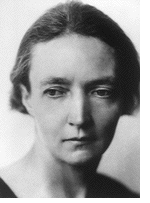Irène Joliot-Curie
physical chemist, b. 12 September 1897 (Paris, France), d. 17 March 1956 (Paris)
 Irène Curie was the daughter of Pierre and Marie Curie. Having shown the same strong interest in physics as her parents, she became her mother's laboratory assistant in 1918 while studying for her own doctoral degree. In 1925 she graduated with a thesis on the alpha rays of polonium. The same year she met Frédéric Joliot and married him the following year, taking on the name Joliot-Curie.
Irène Curie was the daughter of Pierre and Marie Curie. Having shown the same strong interest in physics as her parents, she became her mother's laboratory assistant in 1918 while studying for her own doctoral degree. In 1925 she graduated with a thesis on the alpha rays of polonium. The same year she met Frédéric Joliot and married him the following year, taking on the name Joliot-Curie.
Curie's scientific research concentrated on natural and artificial radioactivity, transmutation of elements, and nuclear physics. During 1926 - 1928 she guided her husband in improving his laboratory techniques. Beginning in 1928 Irène and Frédéric worked and published together.
In 1934 their joint work led to the discovery of artificial radioactivity. By bombarding boron, aluminium, and magnesium with alpha particles, the Joliot-Curies produced isotopes of the normally stable elements nitrogen, phosphorus, silicon and aluminium that decompose spontaneously, with a more or less long period, by emission of positive or negative electrons. For this work they were awarded the Nobel Prize for Chemistry in 1935.
Irène Curie was appointed lecturer in the Faculty of Science of the University of Paris in 1932 and professor in 1937. Although she continued to work and publish with her husband she devoted much time to the upbringing of their two children. The rise of National Socialism in Germany caused her to also spend considerable energy on social activities. She joined the Socialist Party in 1934, the same year when she and Frédéric published their paper Production artificielle d'éléments radioactifs. Preuve chimique de la transmutation des éléments (Artificial production of radioactive elements. Chemical proof of the transmutation of elements) that gave them the Nobel Prize.
In 1935 Curie became a member of the Comité de Vigilance des Intellectuels Antifascistes (Vigilance Committee of Anti-fascist Intellectuals). She became active on the side of the Republican forces in the Spanish Civil War in 1936 and was one of three women in the Popular Front government. The same year she was appointed Undersecretary of State for Scientific Research.
With the increasing likelihood of a German invasion the Joliot-Curies decided to discontinue their research on nuclear fission and make sure that the results of their work could not fall into fascist hands. In 1939 they deposited a sealed envelope at the Académie des Sciences with a joint paper describing the principles of a nuclear chain reaction and changed the direction of their research towards biological and medical applications. Under the German occupation Irène assisted her husband in the Resistance until 1944, when she and their children took refuge in Switzerland.
After the war Irène Joliot-Curie was appointed Director of the Radium Institute of the University of Paris and a Commissioner for Atomic Energy. She took part in the construction of the first French nuclear reactor that came on line on 15 December 1948. She developed the plans for the large centre for nuclear physics at the Université d'Orsay and its synchro-cyclotron of 160 million electronvolts. She continued her social involvement through membership in the Comité National de l'Union des Femmes Françaises (National Committee of the Union of French Women) and in the World Peace Council.
Irène had always been of unstable health, and the Joliot-Curies had taken regular trips to the countryside to assist her condition. Shortly after 1950 her health declined visibly. A stay in the mountains in 1956 did not bring any improvement. She died from leukemia shortly after. The completion of the synchro-cyclotron was supervised by her husband, who also succeeded her in the Chair of Nuclear Physics at the University of Paris to complete her unfinished work.
References
Encyclopaedia Britannica 15th ed. (1995) Frédéric and Irène Joliot-Curie.
Nobel e-Museum, the Official Web Site of The Nobel Foundation (2004) Irène Joliot-Curie. http://www.nobel.se/chemistry/laureates/1935/joliot-curie-bio.html (accessed 29 July 2004); based on Nobel Lectures. Chemistry1922-1941, Elsevier Publishing Company, Amsterdam, 1966.
home
 Irène Curie was the daughter of Pierre and Marie Curie. Having shown the same strong interest in physics as her parents, she became her mother's laboratory assistant in 1918 while studying for her own doctoral degree. In 1925 she graduated with a thesis on the alpha rays of polonium. The same year she met Frédéric Joliot and married him the following year, taking on the name Joliot-Curie.
Irène Curie was the daughter of Pierre and Marie Curie. Having shown the same strong interest in physics as her parents, she became her mother's laboratory assistant in 1918 while studying for her own doctoral degree. In 1925 she graduated with a thesis on the alpha rays of polonium. The same year she met Frédéric Joliot and married him the following year, taking on the name Joliot-Curie.